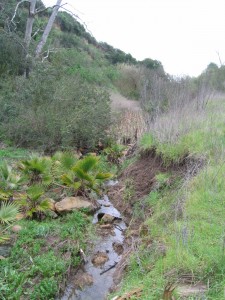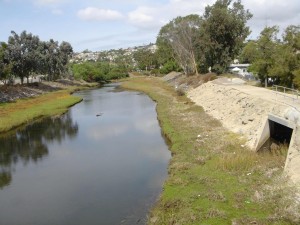Water is the lifeblood of a watershed. Its drainages and streams are the circulation system that not only transports water, but also nutrients, sediments, and pollutants that can both enrich and degrade natural resources as they are transported downstream.
Water enters the Rose Creek Watershed in two primary ways; from the sky as the watershed captures rain after a storm; and through the storm drain system, which directs storm water and dry weather runoff from the city’s streets through a system of pipes to the creeks and eventually to Mission Bay. In carrying water from the upper reaches of MCAS Miramar to Mission Bay, San Clemente and Rose creeks support the plants and animals that the public enjoys in Marian Bear Memorial Natural Park, Rose Canyon Open Space Park and Mission Bay Park, creating an oasis of nature adjacent to urban development. Water in this manner moves native seeds through the watershed allowing more urbanized areas downstream to benefit from the rich biodiversity upstream on MCAS Miramar.

Lakehurst Canyon, a tributary of San Clemente Creek, is degraded by erosion and invasive non-native palms.
That same enriching water can degrade natural resources and threaten public safety if it moves too fast through the watershed or moves at a volume greater than the creeks and storm drain system can support. Problems include erosion that can undermine the natural flow of a stream, “down-cutting” the banks to destroy trails and natural features and create public safety concerns for hikers and cyclists. In addition, when a stream is down-cut the water is often transported in a much narrower channel, no longer spreading across the land to nurture adjacent riparian plants and animals.
Water can also transport matter detrimental to the health of the watershed including invasive and exotic seeds such as Pampas Grass that can take over entire canyons and out-compete native plants, thus making the watershed less able to support native wildlife. Water also transports pollutants, causing our creeks to be unhealthy and beaches to be closed.

